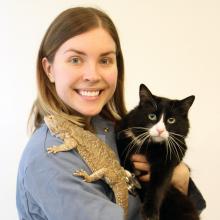When I first thought about becoming a veterinarian, I have to admit that the thought of working with large animals hardly crossed my mind. Although I’ve always loved all animals, I had also always lived in the city and had only touched a horse or cow a handful of times growing up. Getting to work with horses and cows throughout vet school definitely improved my confidence with these animals, but I was still set on streaming small animal at the end of the day.
However, since going out on a variety of large animal calls with the vets during my externship, I’ve started to think that maybe I should’ve streamed mixed animal after all! I’ve really enjoyed getting out of the clinic, driving around the beautiful landscape and getting to work with animals in the fresh air. I’ve definitely got the chance to get my hands dirty – you know it’s been a good day when you come back to the clinic with mud (and often poop) stained coveralls and boots!
.jpg) Some of the beautiful views I’ve seen driving to farm calls!
Some of the beautiful views I’ve seen driving to farm calls!
One of the highlights of my large animal work at Berry Vet Clinic so far was getting the chance to help with de-worming sheep. At first, the vet chased and caught the sheep while I administered an oral de-worming medication to each sheep. Getting the sheep’s mouth open and all of the medication in quickly was difficult enough – but I had no idea what I was in for when the vet asked me to catch the sheep! She had made it look .jpg) so easy, but as a novice sheep wrangler it was definitely no easy feat. At one point, one of the sheep was practically dragging me around the pen as I tried to keep my hold on it. It was a bit of a rodeo, but a lot of fun, and by the end of the day I felt like I was finally getting the hang of it!
so easy, but as a novice sheep wrangler it was definitely no easy feat. At one point, one of the sheep was practically dragging me around the pen as I tried to keep my hold on it. It was a bit of a rodeo, but a lot of fun, and by the end of the day I felt like I was finally getting the hang of it!
I’ve also really enjoyed getting the chance to work with cattle, both dairy and beef. In Phase 2 at the Ontario Veterinary College, we have the chance to practice rectal palpation on cows and identify reproductive organs such as the uterus and ovaries. A big part of cattle herd health visits is diagnosing a cow’s stage in her estrus cycle to determine when to breed her, as well as diagnosing pregnancy and stage of pregnancy in bred cows. During my externship, I’ve learned how vital this skill is for any large animal veterinarian to have.
At OVC, we have the chance to palpate open (non-pregnant) cows, but I finally got the chance to palpate some pregnant cows for the first time! The cows I got to palpate were fairly far along in their pregnancy, so I could actually feel the placentomes (connections between the fetal and maternal side of the placenta) and even the skull of the fetus in one case. It was really cool to actually be somewhat confident in what I was palpating, and to not just be blindly feeling around. It definitely helped to have the vet palpate first and tell me what to look for however! (On the right, a guide to rectal palpation for pregnancy diagnosis.)
Another cool large animal case I was involved in was the delivery of twin calves. A farmer called us out because one of his dairy cows was having trouble calving. The vet used calving straps to pull out a bull (male) calf who was pretty large in size. It’s always important to check if there’s another calf inside the cow, but with the size of the first calf we doubted there would be. However, we soon learned that we spoke too quickly – sure enough .jpg) there was another calf waiting to come out! The second calf was a heifer (female), which means that the calf is likely to be something called a freemartin. Freemartinism is an interesting phenomenon that happens with male-female twin calves due to the placental physiology. Early in pregnancy, placental fluids and blood are exchanged between the twin calves, and the female twin is exposed to the male hormones. The presence of male hormones impairs proper development of the female reproductive system, and the female calf is often born with absent or non-functional uterus and ovaries. Unfortunately, a female freemartin calf will be unable to reproduce because of this.
there was another calf waiting to come out! The second calf was a heifer (female), which means that the calf is likely to be something called a freemartin. Freemartinism is an interesting phenomenon that happens with male-female twin calves due to the placental physiology. Early in pregnancy, placental fluids and blood are exchanged between the twin calves, and the female twin is exposed to the male hormones. The presence of male hormones impairs proper development of the female reproductive system, and the female calf is often born with absent or non-functional uterus and ovaries. Unfortunately, a female freemartin calf will be unable to reproduce because of this.
It was a great feeling to watch two calves come into this world alive and healthy! Who knows, maybe some work as a large animal vet will be in my future after all. Until then, I’m just trying to make the most of my time here at Berry Vet Clinic, both in the clinic and on the farm. I’m sure I’ll have many more interesting cases to share with you in the coming weeks!
